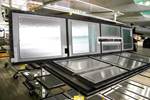Diehl Aviation matures recyclable composite Eco Bin
Overhead baggage compartment using only fiber-reinforced thermoplastics, metal hardware and no adhesives wins Crystal Cabin Award, supports circular aircraft interiors.
Source | Diehl Aviation
(Überlingen, Germany) has been awarded the Crystal Cabin Award in the Sustainable Cabin category for its matured Eco Bin concept, a fully recyclable composite overhead stowage compartment (OHSC) focusing on sustainability and efficiency in aircraft cabin design.
The Crystal Cabin Award’s Sustainable Cabin category honors innovations that redefine environmental responsibility in aircraft interiors. Entries in this category focus on reducing COâ‚‚ emissions, minimizing waste and enhancing resource efficiency while maintaining a high level of passenger comfort and experience.
Diehl’s Eco Bin simplifies dismantling and recycling with the use of two primary materials: fiber-reinforced thermoplastics for the structure and metal for the hardware (such as handles, hinges and screws) — eliminating use of glue or adhesives and complex multi-material components. More specifically, the OHSC structure consists of a thermoplastic sandwich featuring organosheets and thermoplastic core. According to Diehl, the thermoplastic sandwich has a low CO2 equivalent compared to currently used versions.
At their end of life — or up to 20 years, Diehl — Eco Bins can be shredded, melted down and repurposed into other aircraft interior parts, such as brackets or as parts of window frames.
During production, this materials use reduces waste by two-thirds, and is manufactured through an energy-efficient continuous process, which accelerates production compared to traditional methods.
Additionally, the Eco Bin meets flame, smoke and toxicity (FST) regulations, ensuring high safety standards while contributing to a more sustainable cabin environment.
Industrialization of the Eco Bin is planned for 2026. By introducing fully recyclable cabin components, Diehl Aviation says it is helping airlines reduce their environmental footprint while improving efficiency and circularity in aircraft interiors.
Related Content
-
Infinite Composites: Type V tanks for space, hydrogen, automotive and more
After a decade of proving its linerless, weight-saving composite tanks with NASA and more than 30 aerospace companies, this CryoSphere pioneer is scaling for growth in commercial space and sustainable transportation on Earth.
-
Plant tour: Airbus, Illescas, Spain
Airbus’ Illescas facility, featuring highly automated composites processes for the A350 lower wing cover and one-piece Section 19 fuselage barrels, works toward production ramp-ups and next-generation aircraft.
-
Development of a composite liquid hydrogen tank for commercial aircraft
Netherlands consortium advances cryogenic composites testing, tank designs and manufacturing including AFP, hybrid winding, welding of tank components and integrated SHM and H2 sensors for demonstrators in 2025.






